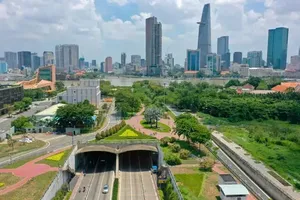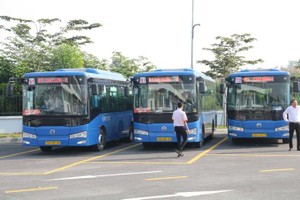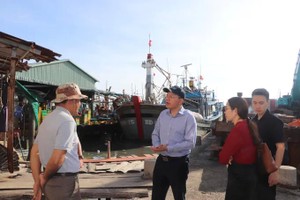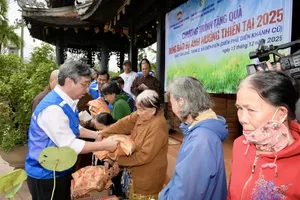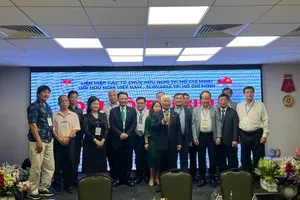
When commenting on the challenges that HCMC is facing, he agrees that this high position is unavoidable as there are around 400,000 businesses and manufacturers of various fields in the city, hiring approximately 4.5 million employees.
In 2017, there were more than 1,500 cases of work accidents, 122 of which resulted in mortality of 123 people, an increase of 4 compared to 2016. The urgent task at the moment is how to gradually reduce this number effectively.
He also states that the financial allocation for work safety training in the whole country is not at all adequate although businesses in general are interested in optimizing this training process as well as possessing the human resources to fight against industrial accidents successfully.
The supposed budget for the national work safety program is around VND700 billion (approx. $30.63 million), but the real expense is only VND200 billion ($8.75 million), along with a sponsor of VND200 billion ($8.75 million) from the Denmark government. If disbursed timely, the expenditure for work safety in the period of 2016 – 2020 is only over VND100 billion ($4.37 million).
The good news is that the law on occupational safety and hygiene allows a large amount of resource when it spends 10 percent of the fund of employer's liability insurance on preventative activities. This should be better taken advantage of to organize proper training sessions or practical solutions to stop industrial accidents.
One very prominent issue in occupational safety and hygiene is the focus on a safe working environment. According to warning of the International Labor Organization (ILO), there are around 2.3 million employees dying each year due to work accidents and diseases (350,000 people and nearly 2 million people, respectively). This fact should be carefully evaluated and analyzed in the situation of HCMC in particular.
What we need to do is to minimize the number of fatality in construction sites, manufacturers, and companies. We also have to reduce the chance of employees contacting toxic substances in their working environment in order to avoid occupational diseases, which are now accounting for 6/7 of the mortality.
There is an unpleasant fact that many workers unknowingly die 5 to 10 years after stopping working due to occupational diseases, and Vietnam, especially HCMC, is very concerned about this.
Discussing about filing a lawsuit over work accidents, Mr. Tho comments that almost all causes of those accidents are humans, most of whom are managers. Many business owners are displeased when they are sued because of industrial accidents, saying that they should not be blamed for what their employees do. Yet the truth is managers must be blamed since they do not provide adequate training sessions as well as careful monitoring on work safety process.
Take the construction requirements of the Ministry of Construction as an example. According to Mr. Tho, when closely observing all regulations on work safety at construction sites with all safe banisters, personal fall arresting systems, warning line systems, and safety net systems, it is harder to have occupational accidents than not. Yet in reality, many construction sites lack safe banisters while the personal fall arresting systems are not connected with stable and high-quality hooks or there are not enough safety net systems.
This shows that improving work safety should first aim at the administrative systems and managers of businesses.
Each year, not even 5 cases of fatality due to work accidents are asking for criminal proceedings. The administrative proceedings and punishments are not serious enough to correct those illegal habits.
Explaining the reasons for this situation, he says that the regulations on work safety and hygiene have only been coming into effect for 2 years when the law of work safety and hygiene is issued. What is more, the system of requirements has only been finished for 5 years.
Before that, all actions focused on dealing with results of occupational accidents regarding employees. However, with an improvement in the law system, from now on, the responsibilities of each involved side will be clearer, making it much easier to file a lawsuit, especially over accidents that cause deaths.
When commenting on the relationship between the strictness and rigor of the law and the arrangement among involved people in a work accident, Mr. Tho says that the compensation in many cases can account for only a minor part of all potential negative results that an employee has to endure because of occupational accidents. Workers in those cases are clearly the disadvantaged ones.
In addition, if most cases are solved by arrangements between employers and injured employees, the strictness of law will be greatly reduced. Therefore, when having appropriate information, governmental bodies must conduct an investigation on causes and responsibilities of each accident to issue proper proceedings, earning more trust from citizens.
When asked about the solutions for HCMC regarding occupational accidents, Mr. Tho shares that the city has already submitted a document on very effective solutions on safety in work. Yet what it needs right now is a more thorough investigation on implementing work safety process as well as support from the government so that businesses are able to create a system of prevention and control risks.
Only when we raise our awareness of work safety and control accidents effectively with practical solutions can we dream about a reduction of the number of accidents. Other solutions on making policies, investing into resources, or other similar policies, if not practical in identifying risks in working, will soon become a failure.



